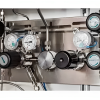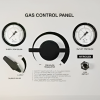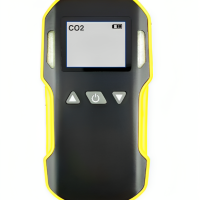![]()
![]()
![]()
Gas Detection Control Panel
Specifications
- Number of sensor inputs: Gas control panels may have a varying number of sensor inputs, ranging from a few to hundreds of inputs, depending on the size and complexity of the application.
- Gas detection range: Gas control panels are designed to detect a range of gases, and the detection range will vary depending on the specific application. Some gas control panels can detect a broad range of gases, while others are designed to detect specific gases.
- Alarm settings: Gas control panels typically have adjustable alarm settings that allow users to set alarm thresholds for each gas sensor. This ensures that alarms are activated when gas levels reach a predetermined threshold.
- Display panel: Gas control panels may have a display panel that shows the concentration of gases in real-time, as well as other important information such as alarm status and system diagnostics.
- Communication interfaces: Gas control panels may have various communication interfaces such as Modbus, Ethernet, or RS-485 to allow for easy integration with other safety systems.
- Battery backup: Many gas control panels have a battery backup system that ensures continued operation during power outages or other emergencies.
- Enclosure type: Gas control panels may come in different types of enclosures such as NEMA 4, NEMA 4X, or explosion-proof enclosures depending on the application environment.
Features
- Gas sensors: Gas control panels come equipped with gas sensors that can detect the presence of various gases in the environment. These sensors are designed to detect toxic, combustible, and oxygen-depleting gases.
- Alarm systems: Gas control panels have built-in alarms that can alert workers to the presence of dangerous levels of gas. Alarms can be visual or audible and may include flashing lights or sirens.
- Control functions: The control unit of a gas control panel can be programmed to control ventilation systems, gas valves, and other equipment to reduce the risk of a gas leak or explosion.
- Data logging: Many gas control panels come equipped with data logging features that allow users to monitor gas levels over time. This data can be used to identify trends and potential hazards.
- Remote monitoring: Gas control panels can be connected to a central monitoring system that allows users to monitor gas levels and alarms remotely. This is especially useful in large industrial or commercial settings.
- Communication interfaces: Gas control panels can be integrated with other safety systems using communication interfaces such as Modbus, Ethernet, or RS-485.
- Battery backup: Many gas control panels have a battery backup system that ensures continued operation during power outages or other emergencies.
Gas control panel, also known as a gas detection control panel, is an electronic control unit designed to monitor and control the concentration of gas in a given environment. Gas control panels are commonly used in industrial and commercial settings, where the release of toxic or flammable gases can pose a serious risk to workers and equipment.
The gas control panel typically consists of a central control unit, display panel, and a series of sensors that are strategically placed throughout the environment. These sensors can detect the presence of various gases, including combustible gases, toxic gases, and oxygen depletion.
Gas control panels may also include additional features such as data logging, remote monitoring, and communication interfaces to allow for easy integration with other safety systems.
Applications
- Chemical plants.
- Manufacturing facilities.
- Laboratories.
- Oil and gas refineries.
- Wastewater treatment plants.
Standards and Certifications
- IEC 60079
- ANSI/ISA-12.13.01-2013
- UL 864
- CSA C22.2 NO. 30
- IECEx certification
- FM approved
- CE marking
Also check out Fire Alarm Control Panel.










